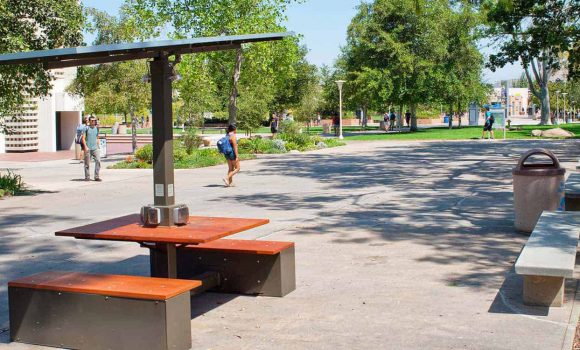When thinking about how to improve campus sustainability, many of us are left with a feeling of “what can I do for the environment?” and “how can we make our business more sustainable?”
Others wonder if they can create an outdoor classroom environment given the recent worldwide change in working conditions.
While there are a few commonly known practices, for the most part, it is relatively simple to maintain a “green” lifestyle; it is more just a matter of adjusting awareness and behavior.
Every year, many students and faculty members are looking for ways to make an impact on the environment and go green at school with some great environmental sustainability projects.
We can help you WOW your current and future students by planning one project that will be sure to create some buzz on campus.
Check out how Bowling Green State University created sustainable outdoor working spaces on campus!
Credit: WTVG 13abc
Need an Innovative Green Idea?
Add solar powered tables to hot spots on your campus!
See the Campus XLView Solar WorkstationsThe Definitive List – 55 Campus and Business Sustainability Ideas
1. Take notes electronically – Instead of using paper notebooks and agendas, use your laptop to take notes and keep track of assignments and meetings. Solar outdoor classrooms have become a new trend that many schools and businesses are implementing!
2. Purchase reusable bags – Not only are these great for groceries, they can also be used to carry other classroom items and supplies.
3. Invest in one good water bottle – Stop buying and using plastic water bottles. Instead, find a nice, reusable bottle (can be found at any pharmacy) to refill throughout the day. If water quality is a problem, simply buy a filter for your sink, or a pitcher with a built-in water filter to keep in the refrigerator.
4. Recycle – One of the oldest tricks in the “sustainability book” is also one of the most effective. If your room or building does not have a bin available, request one from your school.
5. Compost – See if it is possible for your campus to provide a compost bin for food waste from the cafeteria.
6. Create a campus garden – Plant a garden to beautify your space, or use it to grow some of your own vegetables.
7. Be smart about transportation – It is widely known that automobile emissions are a significant contributor to pollution. Offset this by biking or walking where possible, or take your campuses public transportation to classes.
8. Check your lighting – CFL or LED bulbs not only provide a better quality of light, but they also use less electricity.
9. Only use what you need – So much power goes to waste when we leave lights and devices on when they are not in use. Be sure to flip the switch when you leave the room & unplug your devices when they are finished charging.
10. Use real dishes and towels – Plastic or paper cutlery, plates, and towels are wasteful. Buy a set of silverware and plates to use whenever possible and opt for dishtowels that can be reused instead of paper.
11. Make the most out of your laundry – Wash your clothes only when you have a full load, switch to cold water wherever possible and hang items to dry instead of using the dryer.
12. Donate – Give all clothes you are not using to Goodwill, they will also accept furniture and other household items you don’t have use for after you move out.
13. Buy green – Do your research on what products are green and good for the environment before you buy. Some products, such as laundry detergents and hair products, may have labels indicating they are made with environmentally safe, sustainable practices. Also be aware of what you are buying: aerosol sprays and products with microbeads, for example, are very bad for the environment.
14. Go digital – Opt out of receiving snail mail, opt in for email alerts instead.
15. Be an environmental bookworm – If possible; try not to buy new textbooks. Buy used, online versions (if available) or check the library to see if there is a copy you can use for reference.
16. Use less paper – If it is required for your classwork to be printed out, try reducing margins and spacing and print double-sided. It may also be a good idea to ask your professor if you can submit your papers online instead.
17. Buy local – See if there are any farmers’ markets or thrift stores in your area to use in place of malls and supermarkets. Not only does it help offset carbon footprint, you will also find more unique purchases.
18. Use less water – Turn off the faucet when brushing your teeth and cut down on shower time as much as possible to conserve water.
19. Get educated – If you are really interested in environmental sustainability practices, consider pursuing a degree in the field so that you can help to educate others as well. Even if you don’t wish to make a career out of it, many schools offer minors or concentrations so you can learn more about it.
20. Get involved – Join an environmental group, or if there isn’t one already, form one! Connect with your office of sustainability to see what practices are already in place on campus and see how you can help make an impact. Today, many universities offer a variety of sustainability “challenges” (for recycling, turning off lights, etc.) and subsequent rewards and reimbursements for participation.
Contributions by Jennifer Seydel, Greenschoolsnationalnetwork.org:
21. Avoid using straws! Learn more here.
22. Instead of buying paper plates and plastic cups, use compostables instead – Biodegradable eating and party items are much more eco-friendly.
Watch her video here:
23. Reduce your consumption of meat – Meat production in America accounts for the creation of enormous amounts of the greenhouse gas Methane, which accelerates global warming. Try to go vegetable-forward in your meal choices, and save your meat eating for one or two days per week, or for weekends. You’ll be eating a more balanced diet, and helping to reduce emissions.If you’re in the habit of eating meat regularly, and want to shift your habits, start small: Try your next burrito without chicken or skip the pepperoni on your next pizza slice. All of our consumption habits collectively make a major impact on our environment.
24. Carry a thermos, and skip the daily throw-away coffee routine – Coffee cups are one of the most common single-use products in the world. Imagine how many people you see drinking coffee on their way to class every morning. Now imagine that’s happening every day on nearly every campus worldwide.Bringing your own thermos with you reduces waste and sets a good example for those around you to be more thoughtful about their consumption habits.
25. Shop at thrift stores – Buying gently used clothes is the perfect way to keep your style fresh while conserving resources, not to mention preserving the funds in your wallet.Producing new clothes requires lots of energy and resources, such as water, and most clothes are made overseas, which creates an even greater carbon footprint. Buying used clothes from a local thrift store means you’re eliminating the need for all that resource use!
26. Avoid fast fashion and buy Made In The USA – When you do buy clothes new, opt for quality items made in the USA, instead of buying cheaper options made overseas to meet the demand of the next short-lived trend.Save your money for a few quality pieces that will last, instead of continually buying cheaply made clothes that will turn into rags in less than a year. This saves money in the long run and is better for our environment.
27. Pack a lunch – Buying food at the campus food court or from food trucks often results in un-recyclable waste from packaging. Also, the expenses really add up over the course of a semester. Avoid this by planning your meals ahead of time and bringing lunch to campus with you in reusable storage containers. Get nested containers that fit into one another to save space in your backpack.
Contributions by our friends at The Green Campus Initiative:
28. Buy new things/Replace old materials only when necessary – ostentatious living is rather a major problem to conservation. The want for more items which may not necessarily be needed makes people acquire new things that end up as waste in no distant time.Repairing old or faulty items may help prevent this. We can cut down on our need to “show-off” our wealth.
29. Use old/unused materials for other purposes – don’t just throw away stuff that is old just because it’s old. Find other uses for them or gift them out to those in need. One man’s trash is another’s treasure. You can use old items as ornamentals within the house. You can even create your own mini museum of antiques.
30. Grow your food – creating simple vegetable gardens in your backyard will go a long way in cutting down money spent on groceries. With many farmers using chemicals, it also affords the opportunity to eat healthily.
31. Dispose of waste properly – As simple as this is, many people find it hard to drop their waste at the designated disposal sites. The sightings of plastics everywhere is an evidence of this. Burning off of waste is still commonplace as well. Right disposal of waste helps keep the environment clean and safe for all.
32. Sort your waste – waste sorting makes it easy to recycle materials. It also makes you realize the materials you might want to cut the budget on.
33. Be conscious of nature – people get so busy every day chasing a life without the thought of the earth. If the earth is gone where will you continue your daily hustle?
34. Switch off all appliances when not in use – you don’t need an energy economist to tell you this. You get to conserve a lot of energy when you switch off unused light bulbs and electronics at home and in offices.
35. Create a shopping list before leaving home – this is a very simple way to avoid impulse buying and waste creation. This will also help maintain an optimum budget. It’s a good way to learn
36. Schedule your errands – scheduling errands will reduce the amount of time you have to spend moving around. It will also help organize your trips into a chain of activities you will be able to achieve n less time. Lesser driving time means lesser emission.
37. Repair damaged water/plumbing pipes in homes – we need not waste water buy leaving damaged pipes unattended to in buildings. Conduct a routine check often and ensure you are in good shape.
38. Support green businesses – If you are really interested in going green, you should support sustainable businesses. Buy organic foods and eco-friendly materials.
39. Keep a garden journal – keep the records of how you tend to plants in your garden, it will promote your understanding and love for nature.
40. Visit conservation parks/sites – experiences in conserved areas teach you new things that keep you in tune with nature. You can try this to gain inspiration for Biomimicry and nature photography.
Contributions by SUNY College of Environmental Science and Forestry Green Campus Initiative
41. Always remember the five R’s when thinking about what to do (Refuse, reduce, reuse, re-purpose, then recycle)
42. Buy reusable Tupperware and water bottles to use daily for lunches, or carrying home leftovers instead of a “to-go” container
43. Throw cigarette waste into containers – if you choose to smoke, make sure your cigarette does not end up on the ground!
44. Carpool to work, or events with others instead of taking your own car. Even better ride a bike, or the bus!
45. Buy the “ugly” fruit and vegetables at the market, because most of the time they go unsold and are thrown away.
46. Unplug chargers and other cables that aren’t being used, because they are still using electricity by being plugged in!
47. Do your part! “Unless someone like you cares a whole awful lot, nothing is going to get better. It’s not.” – Lorax
Contributions from the U.S. Green Building Council
48. Monitor your energy and water bills – Tracking energy and water use in school buildings involves monitoring, recording, reviewing and analyzing bills and data on a regular basis so that you can identify how energy is used, and reduce costs and consumption.
49. Participate in a Green Apple Day of Service project – The Green Apple Day of Service brings together volunteers, parents, teachers, students, companies, and local organizations to contribute to sustainability projects in schools that create a lasting impact.
50. Put rainwater to use – According to the Chesapeake Bay Foundation, during an average rainstorm more than 700 gallons of water run off the roof of a typical home. After a rainstorm, water is rushing right off of nearby buildings and pavement and back into the local waterways, bringing a whole lot of pollution with it.
By capturing rainwater with rain barrels and water gardens, you can cut down on the amount of runoff going back into the environment, and even use the captured water to water your plants or for non-potable water uses.
51. Train custodians on green cleaning – Green cleaning products and approaches protect health and promotes better learning environments, reducing environmental and chemical hazards that negatively affect childhood growth and development.
Training custodians on effective cleaning processes is essential for helping schools keep kids healthy in school, and achieve their highest potential.
52. Communicate your school’s sustainability values – Signs and murals are great and public ways for a school to show its commitment to healthy and sustainable learning environments and also provide a teaching opportunity for students and adults alike.
53. Learn more about your local watershed – Turn this into a teaching opportunity by learning about where a school’s water comes from, where it goes in storm sewers when it leaves the site, and how that impacts the local environment.
54. Apply for a Green Schools Fellowship – The Center for Green Schools at the U.S. Green Building Council places three-year sustainability directors in school districts through its Fellowship Program. Since 2008, the program has been successful in bringing green practices to school systems that want to make the case, through proven results, for staff capacity to address sustainability.
55. Study for a LEED Professional Credential – The LEED-AP or LEED Green Associate credential signifies that you’re a leader in the field and an active participant in the green building movement.
With jobs specifying the need for green building expertise, a LEED credential shows to employers a clear commitment to professional growth and healthy environments.
Adding phone charging stations to your outdoor event is also a great way to introduce sustainable energy!
Sunbolt products are also a great way to charge your phone while camping.
Add Solar to Save on Energy Costs!
Add solar powered tables to hot spots on your campus!
See the Campus XLView Solar WorkstationsThere are many Universities and businesses that have emerged as leaders when it comes to eco-friendly campuses. The following universities have made a tremendous effort to Go Green with Sunbolt:
We can also provide solutions for contract solar furniture to your university or business campus.
Here’s wishing you and your campus a happy & sustainable Earth Day 2024!
Have some more ideas for this list? Let us know and we may feature your suggestion.
For more information on how you can help your campus “go green” with a Sunbolt solar table charging station, please contact us at info@gosunbolt.com.


